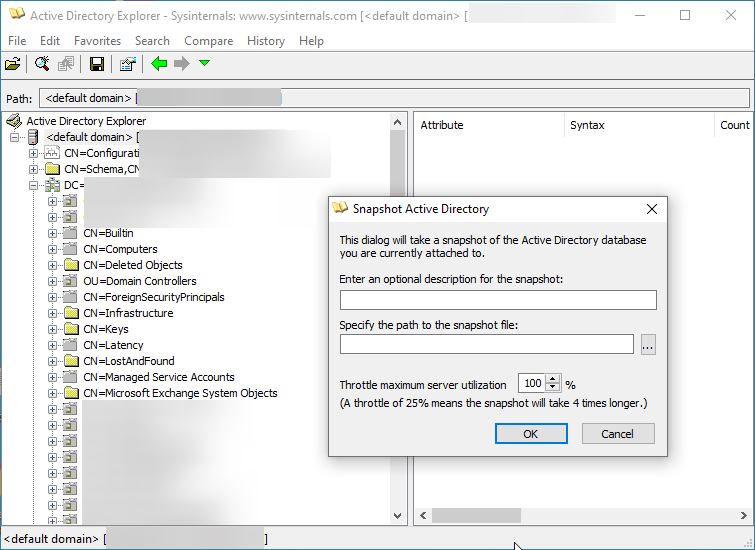ADExplorerSnapshot.py is an AD Explorer snapshot parser. It is made as an ingestor for BloodHound, and also supports full-object dumping to NDJSON.
AD Explorer allows you to connect to a DC and browse LDAP data. It can also create snapshots of the server you are currently attached to. This tool allows you to convert those snapshots to BloodHound-compatible JSON files, or dump all available objects in the snapshot to NDJSON for easier processing.
In BloodHound output mode:
- Users collection
- Groups collection
- Computers collection
- Trusts collection (as visible from the LDAP DC you are connected to)
- Certificate template collection
In Objects output mode, all attributes for every object are parsed and outputted to NDJSON format.
The ingestor for BloodHound only supports offline information collection from the snapshot file and won't interact with systems on the network. That means features like session and localadmin collection are not available. GPO/OU collection is missing. The ingestor processes all data it possibly can from the snapshot (including ACLs), but will only output the JSON data that can be interpreted by BloodHound. You will only have the data available of the LDAP/DC that you ran the snapshot against.
ADExplorerSnapshot.py supports Python 3.6+. Dependencies are managed via pip.
git clone https://github.com/c3c/ADExplorerSnapshot.py.git
cd ADExplorerSnapshot.py
pip3 install --user .
usage: ADExplorerSnapshot.py [-h] [-o OUTPUT] [-m {BloodHound,Objects}] snapshot
ADExplorerSnapshot.py is an AD Explorer snapshot parser. It is made as an ingestor for BloodHound, and also supports full-object dumping to NDJSON.
positional arguments:
snapshot Path to the snapshot .dat file.
optional arguments:
-h, --help show this help message and exit
-o OUTPUT, --output OUTPUT
Path to the *.json output folder. Folder will be created if it doesn't exist.
Defaults to the current directory.
-m {BloodHound,Objects}, --mode {BloodHound,Objects}
The output mode to use. Besides BloodHound JSON output files, it is possible
to dump all objects with all attributes to NDJSON.
Defaults to BloodHound output mode.
Certificate templates can be imported in BloodHound format or BloodHound-ly4k format.
If you use the regular BloodHound version you should only import the cert_bh JSON file (which are imported as GPOs).
If you use ly4k's fork, you should import the cert_ly4k files instead. Some information will be omitted (e.g. for ESC8 whether Web Enrollment is enabled) as it cannot be collected with AD Explorer.
This library is now supporting the BloodHound v6 output format. Older versions were supported in earlier commmits if you still need them. For the old v3 output format, you can use the code in the v3-format branch.
Making snapshots in AD Explorer is more network-intensive than the traditional BloodHound ingestors as it attempts to retrieve all objects it can from the LDAP.
ADExplorerSnapshot.py will create caches of information for quicker lookups while processing the data. Especially when processing larger snapshots (e.g. 4GB+) you will also need to have sufficient RAM available. In my tests, about half of the snapshot file size was required in RAM.
The library was tested with a number of data sets, please create an issue report if you run into problems.
The AD Explorer snapshot parser is implemented as its own module, which could also be used individually.
The format in which snapshots are stored by AD Explorer is proprietary and led to a fun reverse engineering journey. A 010 editor template is included in this repository, which I used for iteratively mapping out the contents of the snapshot into structs.
On an OPSEC-related note, AD Explorer is a legitimate Microsoft tool. When performing a snapshot, only limited queries are made to the LDAP server (objectGuid=*). However, the resultset is huge as all objects and their associated attributes are retrieved. This results in a rather voluminous output.
Detection of this tool is possible in multiple ways, for which I refer to the excellent blog post by FalconForce: FalconFriday — Detecting Active Directory Data Collection — 0xFF21.
This code is licensed under the MIT license and makes use of code that is also licensed under the MIT license.
ADExplorerSnapshot.py relies on the following projects:
- BloodHound.py (the Python BloodHound ingestor): for processing LDAP data.
- dissect.cstruct (C-style binary struct parser): for parsing the binary snapshot data.
- certipy (ADCS enumeration tool): for processing certificate template information.
Credits:
- Cedric Van Bockhaven for implementation
- Marat Nigmatullin for the idea
- The FalconForce team for adding certificate template support
Thanks to Deloitte for providing the environment in which this tool was developed.



